My first project at Bradford School of Arts & Media was to study and research something which we are passionate about and then put that into a collection of images we've generated in any medium we prefer. As I was freshly learning Illustrator in my Techniques and Processes lessons I decided to use the medium of Illustrator.
In preparation for this I did a LOT of research, which can be seen at the bottom of this post.
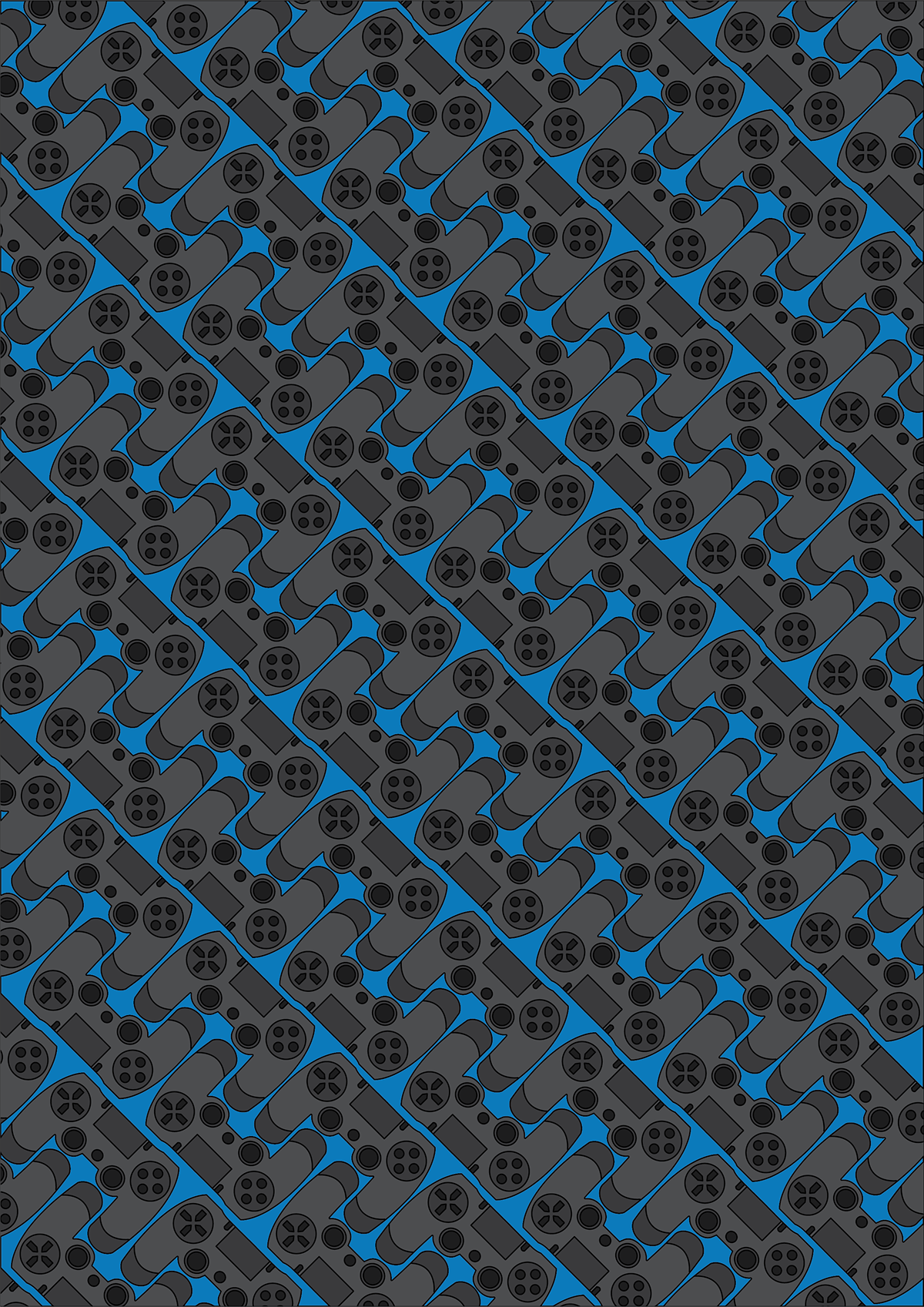
This piece was one of the first things I did in techniques and processes when I was getting to learn illustrator, i liked the result and so this became the main theme of my ENTIRE 'Magnificent Obsessions' brief
So, with this in mind I went on to do my research on the history of gaming and chose just a few of the MANY consoles I discovered to be the main focus of my pieces. I then proceeded to vectorise all of the chosen consoles and their controllers as seen below...
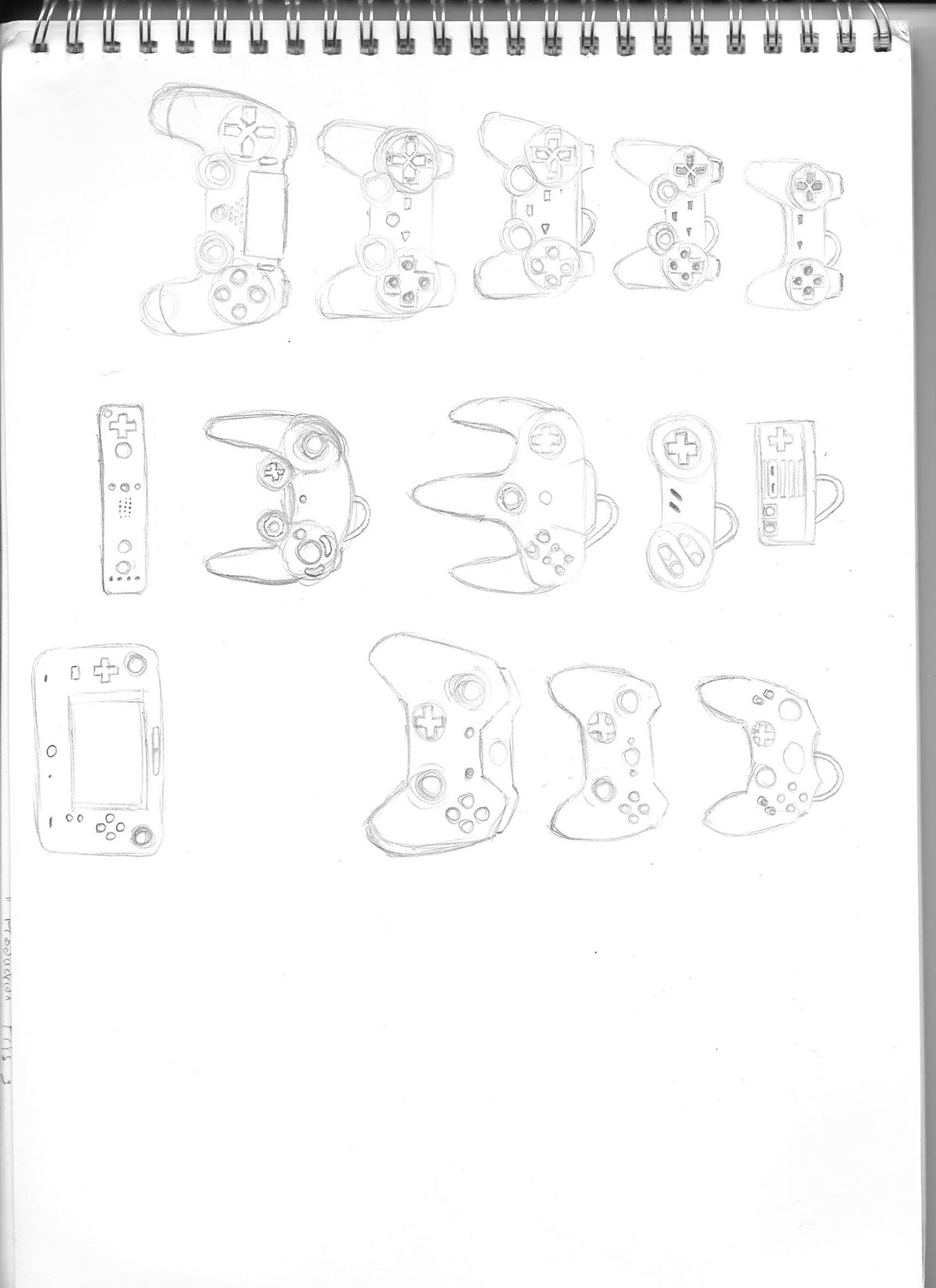
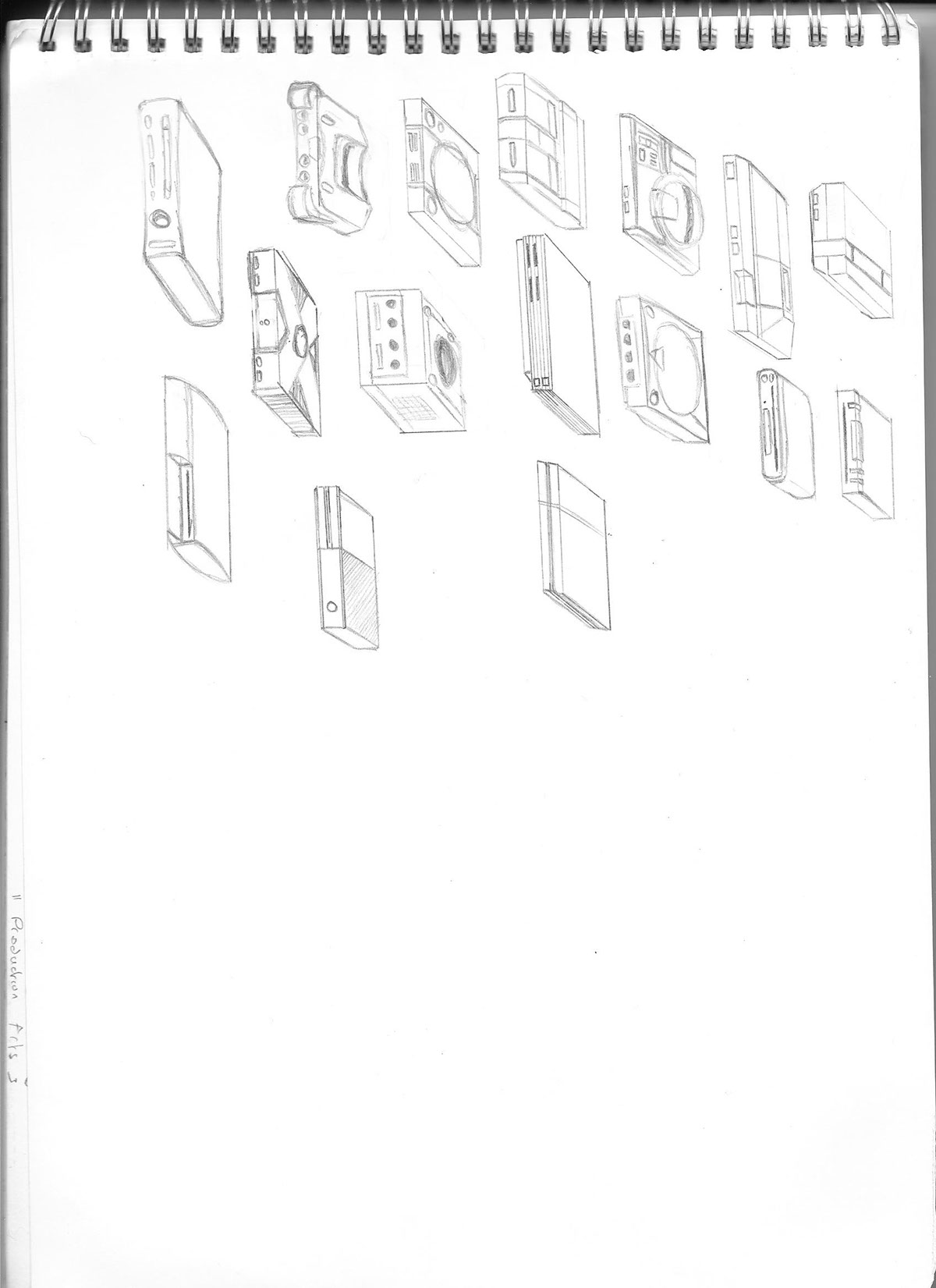

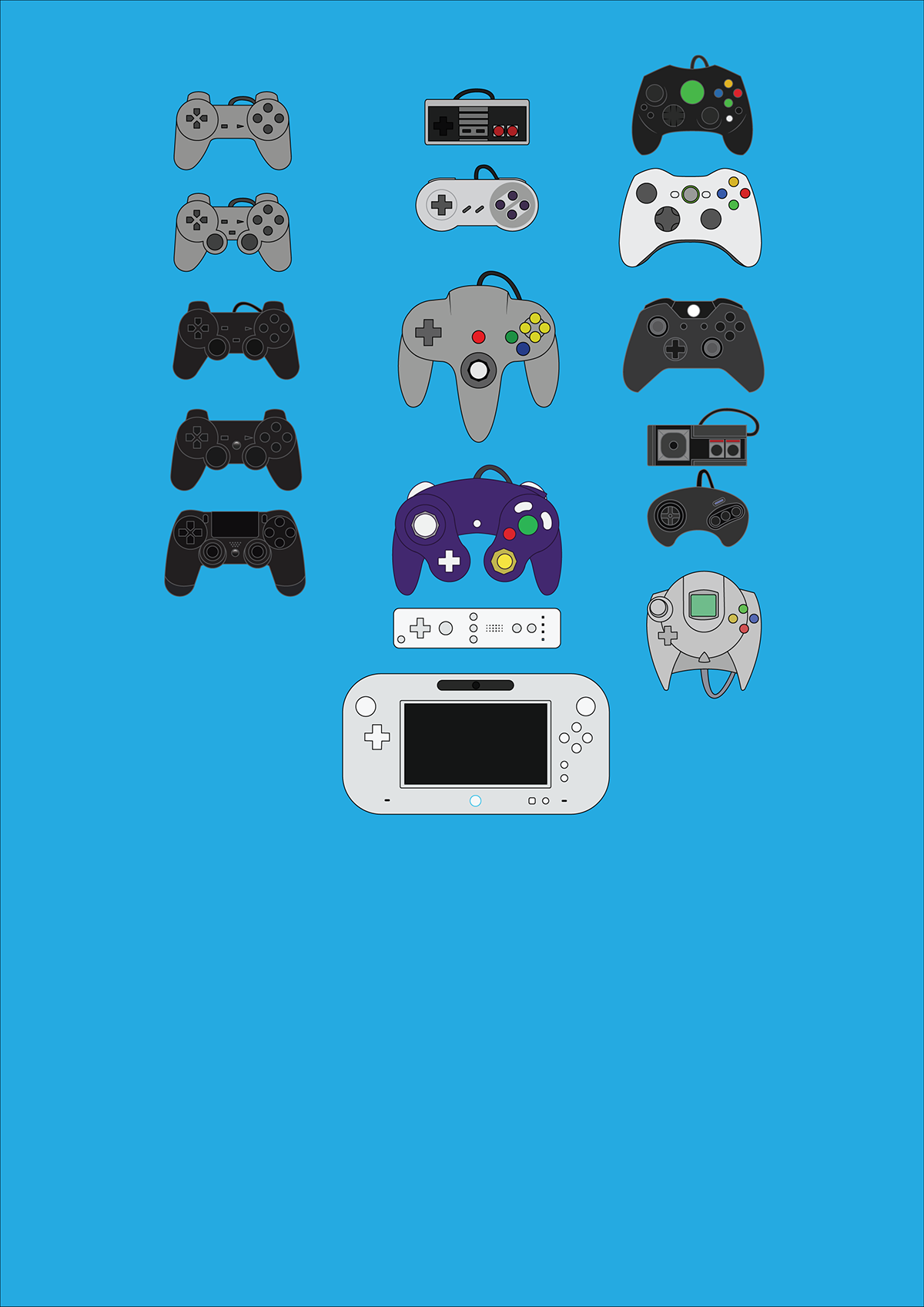
Around this time I also had a strong interest in sprite art, being that sprite art came about BECAUSE of videogames, it seemed appropriate to make a few sprites which I could use if I felt the need, this is the result:

With all of my elements created I began constructing the patterns I spoke of, I did 3 variations for each console, one with the console overlayed, one with the controllers their normal colour and one with limited colours. I did Red for Nintendo consoles, Green for Xbox consoles, Light Blue for Playstation consoles and Blue for Sega. These images then became the main focus of my small book. I composed each page by console with the consoles release date in the corner. I also created an image by composing all of the controllers together in one image and used this image on the front and back inside pages as well as the 'blurb' page. The sprites I made were then used to make the cover while the controller sprites were used as page markers instead of numbers!. I also got a quality print made of this book, which I am greatly pleased with!
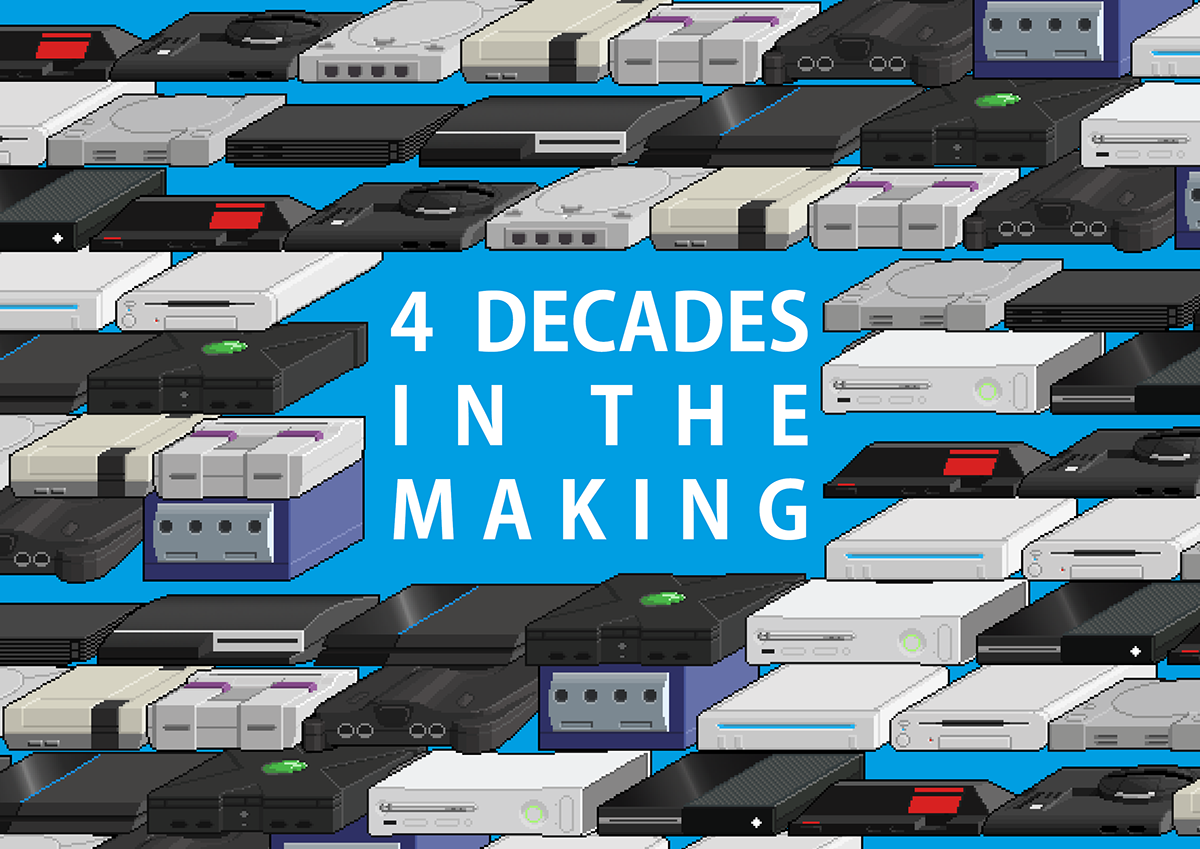
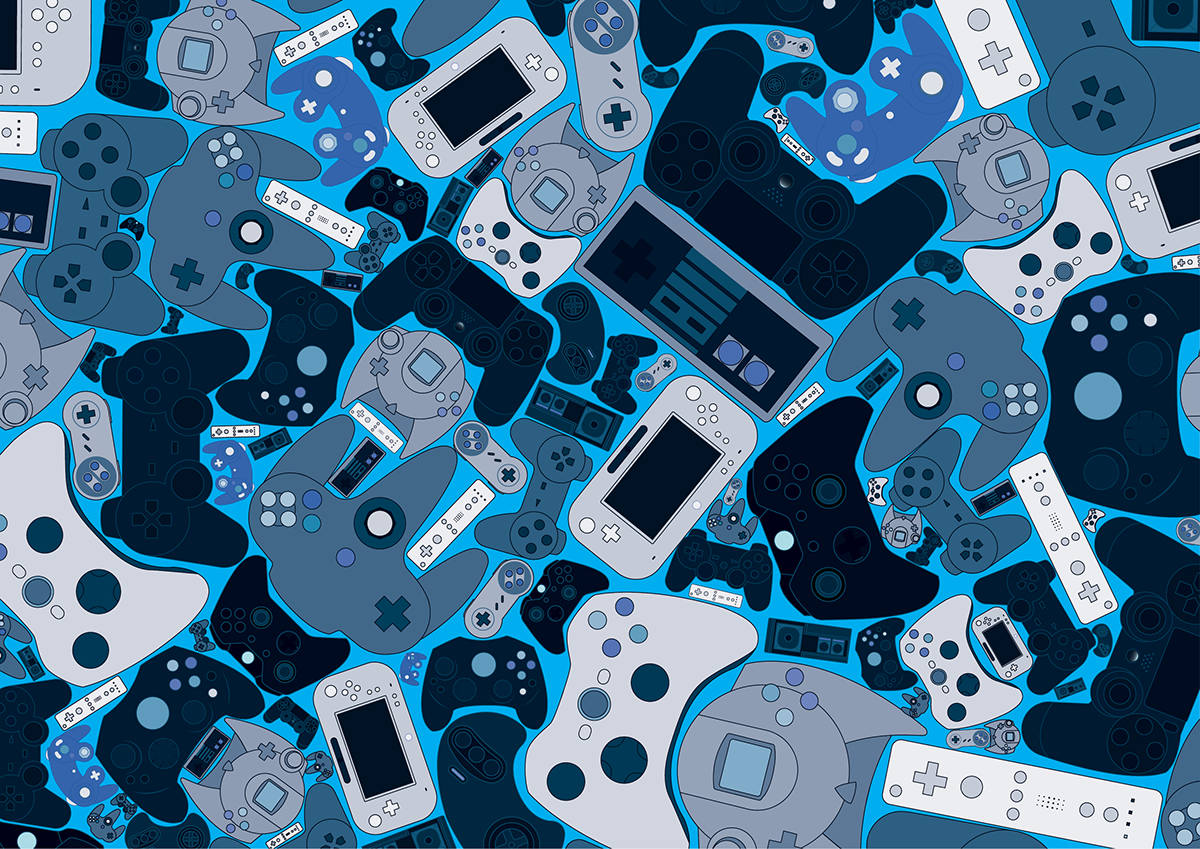
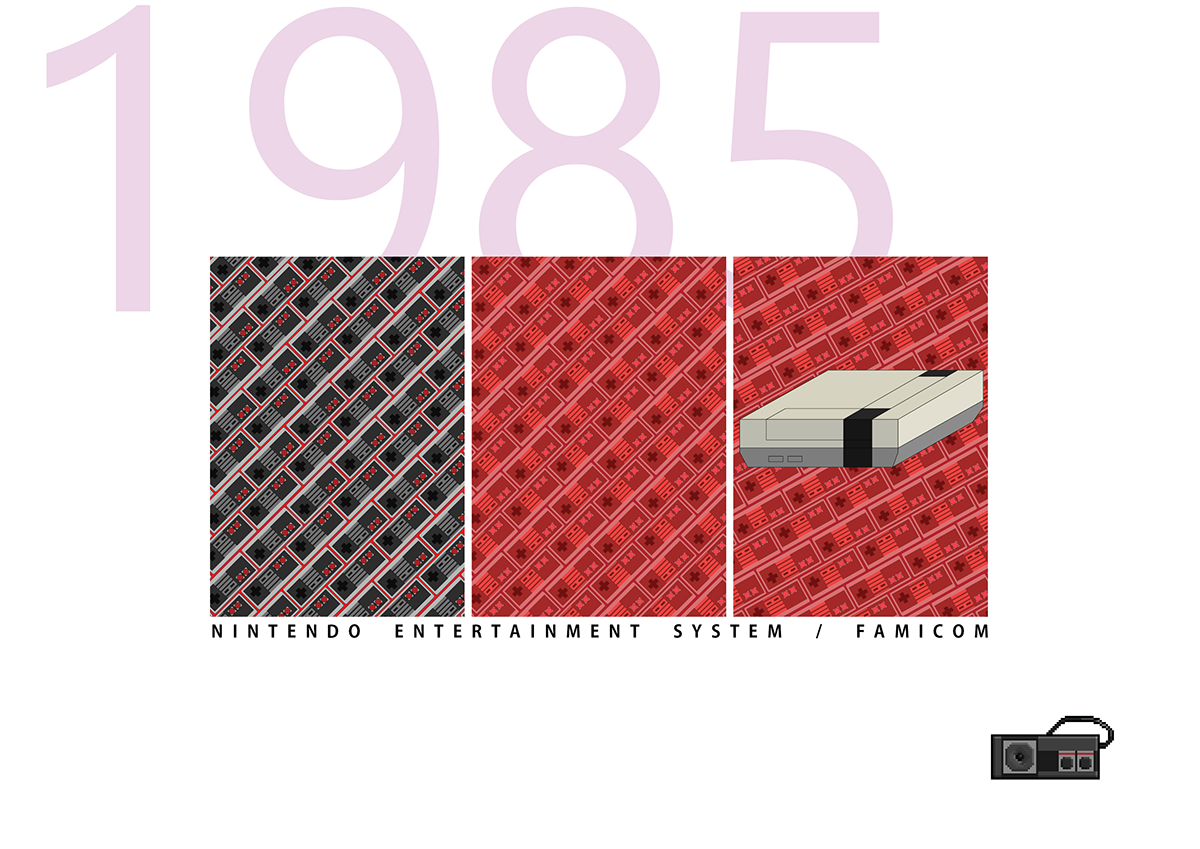
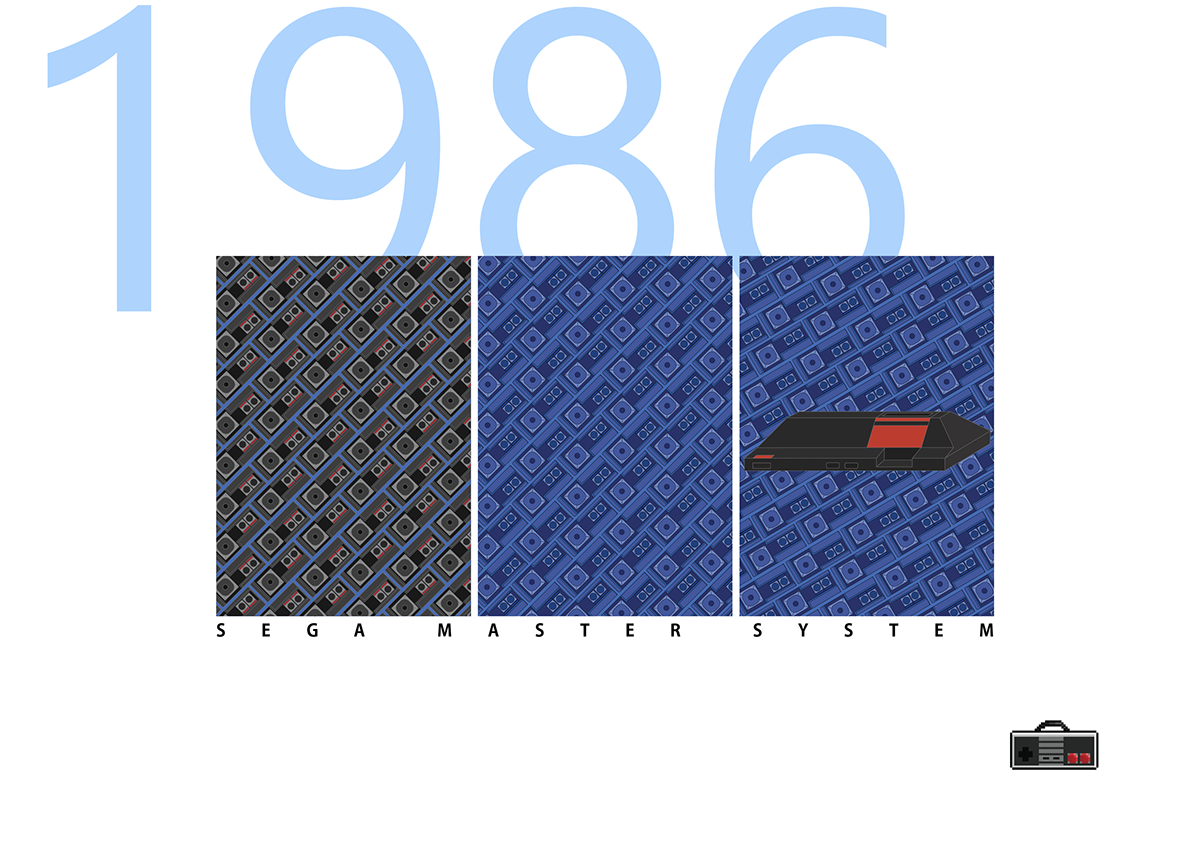
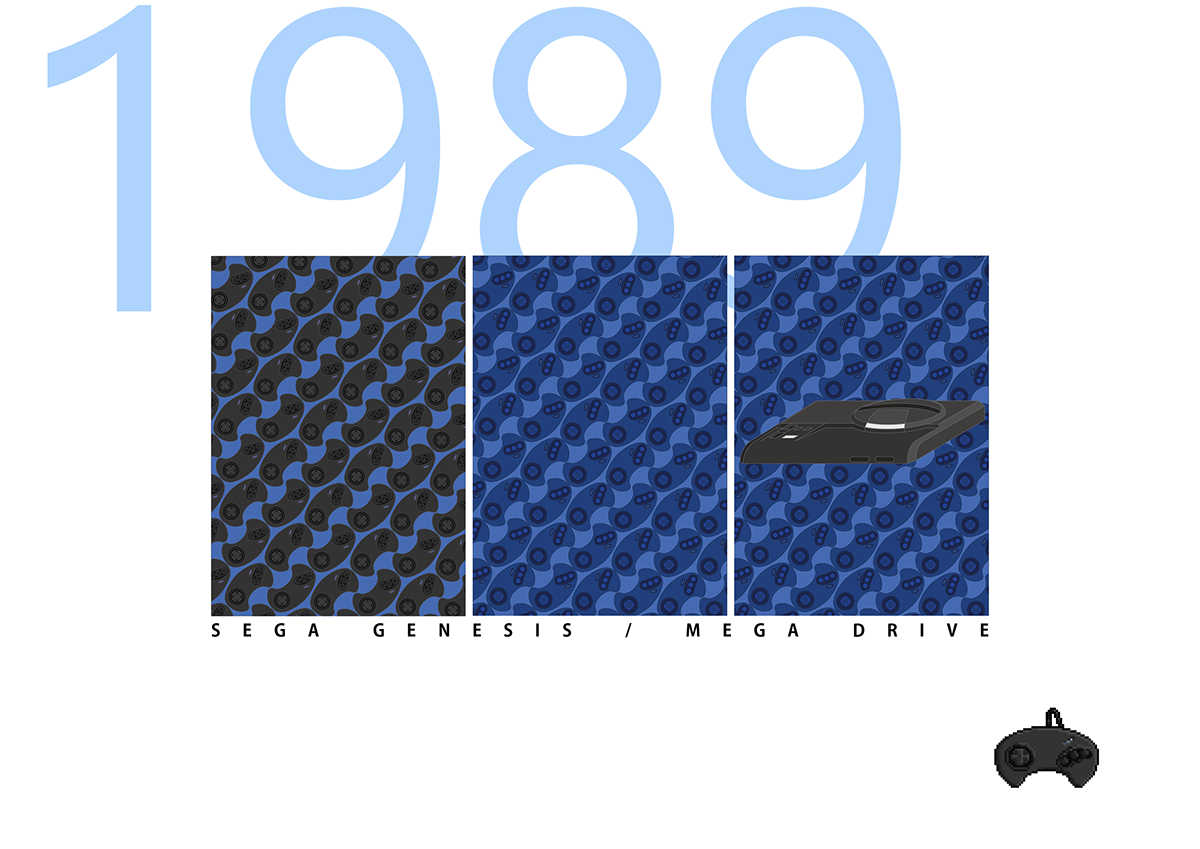













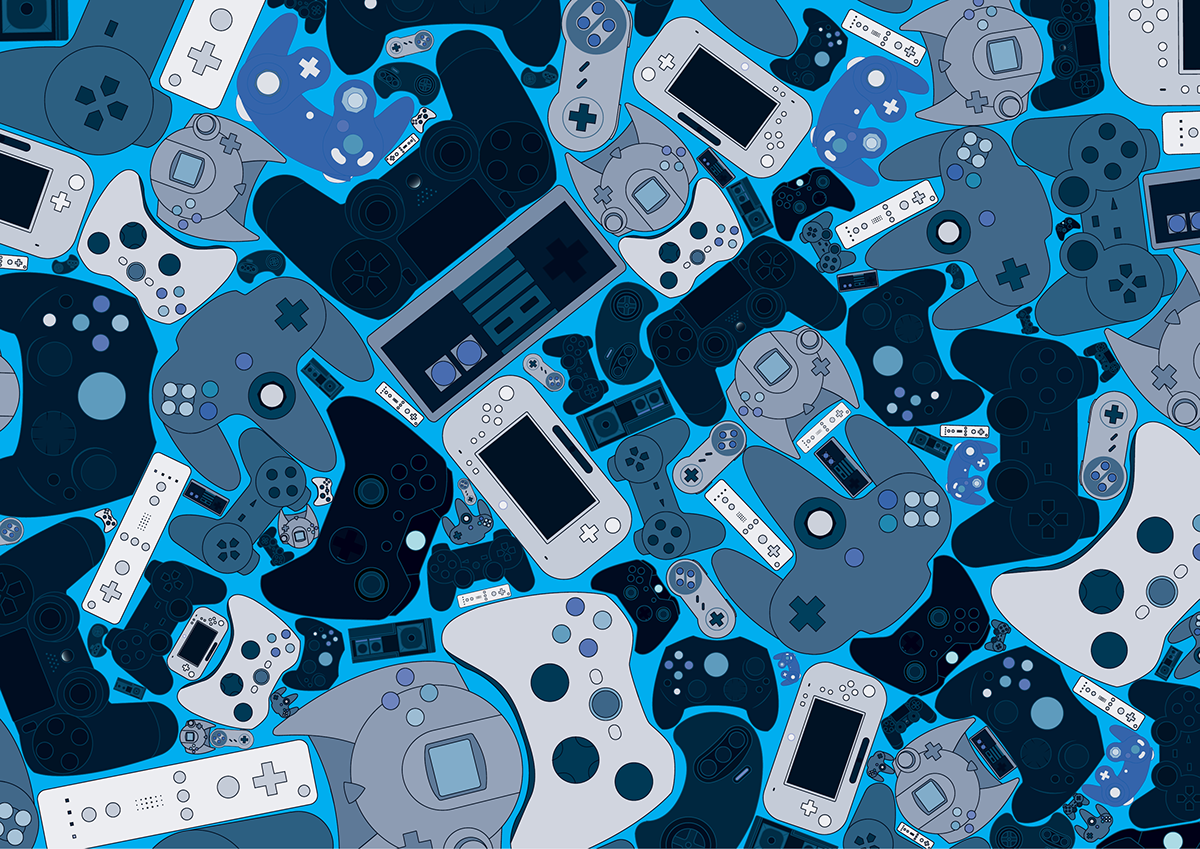

Thats the entire book broken up into pages. I will now display the extensive research I had done for this project...
FIRST GENERATION
The Brown Box
A prototype, created and used by Ralph Baer during the late 60s when demonstrating it's several selectable game modes to TV manufacturers. Without a CPU, it was up to the user to turn on a specific sequence of switches in order to activate the corresponding game.
It used a simple controller with 2 dials, each controlling a separate function.
Magnavox Odyssey
In 1972, Baer finally got backing from 'Magnavox' and released the Magnavox Odyssey, the first commercial home video game console, which would be connected up to a TV set. On this console, the switch system was replaced for a far more convenient 'cartridge' system. This meant that each of the many games were stored on a separate cartridge. This console also used a simple controller with dial controls.
This system also had many variations, in different sizes with different games.
SECOND GENERATION
Coleco Telstar
Coleco Telstar, developed in 1976 had a total of 14 console variants featuring different games, one of which even came with guns as controllers. Otherwise, the controllers usually featured dials.
Video Entertainment System
Developed by fairchild in 1976, the VES (later renamed Channel F) was the first cartridge-based console for which the cartridge actually stored the game data, rather than just telling the console which built-in game to run. This console used a peculiar type of controller which you would "turn, twist, push and pull eight different ways".
Atari 2600
between the years of 1975 (Atari Sears Tele-Games) and 1977 (Atari 2600 VCS) Atari developed many games consoles but, none were as popular as the Atari 2600, which rose up the ranks to become one of the main consoles which we have to thank for the gaming world we have today.
The atari used a simple joystick controller with a single button, which can be recognised by gamers across the world as the classic controller.
Video-game crash of 1977
This is a major event in the evolution of gaming, as a large majority of gamers lost interest completely, sales dropped exponentially and it was increasingly difficult to turn a profit, to resolve this, manufacturers of older consoles and pong clones sold their stock at a loss just to get rid of the surplus, losing thousands of dollars and leaving a huge crater in the gaming market.
Fortunately, Atari released a conversion of the hugely successful arcade game 'Space Invaders' for the Atari 2600 and buyers everywhere NEEDED to get their hands on their favourite arcade game to get the pleasure of play it in their own home.
There is one good thing to come from this crash however, in Europe, because of the crash CPU chips were exponentially cheaper, meaning smaller companies such as Hanimex, Secam and Soundic could release their own systems and made some great progress in expanding the european gaming market.
Mattel Intellivision
Following this Major crash, a lot more attempts at consoles as successful as the Atari 2600 were made, consoles such as the Bally Astrocade came close and even exceeded the console in graphical ability but without the proper marketing or hype, they just fell short. Mattel's Intellivision was one of the greater attempts and it surpassed the 2600 in many ways, but again, it inexplicably fell short.
Video-game Crash of 1983
In 1983 a much more severe crash plagued the world of gaming. There are 3 major reasons blamed for this crash:4
1. Many homes throughout the U.S were finally able to get affordable home computers, meaning PC gaming was growing larger by the day.
2. There was an influx of poor quality cheap consoles with terrible quality games being shipped out from smaller companies everywhere.
3. Atari, the industry leader at the time, were over-hyping games with their superb marketing skills, but when users came to play games such as E.T and Pac-man on their Atari 2600 consoles, they were less than satisfied. Interestingly, the aforementioned E.T game was so bad it is being blamed single-handedly by many sources for the crash and there was a myth going around that Atari actually buried a large quantity of E.T cartridges. This myth was brought to light again this year as an effort was led to dig up the rumoured burial site, where, with many a grin, they did in-fact find thousands of copies of the hallowed game.
Third Generation
Nintendo Famicom/Nintendo Entertainment System
Nintendo, that is a name many of us will remember for quite some time. While they may be failing in many respects to date, we have a lot to thank them for. They saved gaming in 1983 when they released the Family Computer (or Famicom) in Japan. This system supported high resolution 'sprites', far broader colour palettes and Tiled, colourful backgrounds. The combination of these elements produced a beautiful and incredible gaming experience never before seen. They attempted to bring the Famicom into U.S markets prior to the videogame crash, where videogames were seen by many as just a trend, which had passed, like bell-bottom jeans. In order to get around this, they re-marketed the re-designed system as the 'Nintendo Entertainment System' also know as, and widely recognised as, the NES. This system had a front-loading cartridge port like a VCR and came packaged with a very iconic controller, featuring the first ever D-Pad and 4 functional buttons.
Sega Master System
In an attempt at competing with the NES, Sega developed the Master System, however it didn't really gain much of a lead on the far superior NES which was casting a great big shadow. Although it fared much better in European countries when it finally became available there 2 years after it's Japanese release in 1985. This system also featured a flat controller with a D-Pad, although only 2 functional buttons.
Atari 7800/XEGS
After taking the brunt of the blame for the crash of the video-game industry, atari struggled to get back on their feet. Eventually Jack Tramiel bought out Atari, downsized a lot of the staff and worked hard to resolve many legal disputes and then pulled up his trousers before setting out to give the video-games market a shot. They made a smaller, cheaper, sleeker version of the Atari 2600, as well as the Atari 7800. The 7800 was powerful enough to stand up to the NES and was even able to play old 2600 games, and finally, Atari boxed up their 8-bit XE Home computing system as the XEGS game console. These new consoles had a significant effect on the debt Atari faced, but gained nothing in terms of market share compared to Nintendo. On top of this, Atari's lack of budget meant cheaper packaging, cheaper games and limited distribution.
Fourth Generation
TurboGrafx-16
The pioneering console of the Fourth Generation was the TurboGrax-16 Entertainment System (A.K.A the PC Engine in Japan), developed in unison by Hudson Soft and NEC. It was released in 1987 in Japan and brought over to the US in 1989. It was the first console to use a 16-bit GPU, despite still utilising an 8-bit CPU, developed to compete with the NES. The original Japanese console was a smaller white model, but the Western models were larger and black. The controllers were also a flat plastic block featuring a D-Pad and 4 buttons.
Sega Genesis/Mega Drive
In 1988 Sega released their successor to the Master System in Japan, the Mega Drive. In 1989 it was released in North America as the Sega Genesis and released again in Europe during 1990 as the Sega Mega Drive once again. Oddly, it was released in Korea as the Super Aladdin Boy, I couldn't find any explanation for this.
In japan the Mega Drive didn't fair well against the Famicom (NES) or the PC Engine (TurboGrafx-16) but when released to Western Markets it was hugely successful. The best selling game for the Mega Drive was, of course, Sonic the Hedgehog. The first game in the, still hugely popular, Sonic the Hedgehog franchise.
This console used a different kind of controller, better shaped to fit the hands of users (albeit aimed more closely at the younger demographic) and featured 6 buttons and a D-Pad.
Personal Note: This console was my Mother's console of choice, she has rather fond memories of playing Sonic the Hedgehog for hours, and even today can power through the most challenging of levels on a variety of platforms including mobile devices.
SNK Neo Geo
Successful Arcade machine developers SNK saw the Fourth Generation as an Ample Jumping-on point for their own brand of home-console systems and developed the Neo Geo AES (Advanced Entertainment System). This system was based on their Neo Geo MVS technology, which allowed Arcade cabinet owners to simply switch out their cartridge containing 6 different games to offer a variety to Arcade-goers.
The Neo Geo AES had a large controller emulating the input panel on an Arcade cabinet in that it had 4 buttons and a joystick.
This console was equipped with incredible graphics at the time which allowed for the playing of the larger games it came with. However, this led to a very large price tag. The console cost more than 800 dollars and each game cartridge (comprised of 6 games) cost 200 dollars!
SNES (Super Famicom/Nintendo Entertainment System)
In 1990, Nintendo decided it was high time to upgrade the NES with 16-bit graphics. So, they released the Super Nintendo Entertainment System (SNES), also known as the Super Famicom in Japan. The SNES was a global success, Nintendo finally go the upper hand on Sega in the US and Europe and the SNES remained popular well into the 32-bit era, or 5th generation. Even now, retro gamers, collectors and emulation enthusiasts some of whom are still developing home-brew ROMs for the system. This console's controller was similar to it's predecessor's except for the more rounded design and 2 additional buttons.
Introduction of Compact Discs (CDs)
In the first few years of the 90s, Compact Discs became more common and there was a noticeable shift from Cartridge to CD media, as CDs had many Pros over Cartridges. One of these Pros was a much larger capacity, allowing the storage of 3D models which were much more demanding in terms of storage. Many consoles tried to step up to the challenge without having to re-release consoles, by creating add-ons, such as the Sega CD, an attachment for the Mega Drive.
Fifth Generation
Panasonic 3DO/Atari Jaguar
The first fifth-generation consoles were the 3DO and the Atari Jaguar. Both consoles were built for CD media, had powerful 3D graphics and were far more capable than Nintendo or Sega's consoles. The 3DO couldn't be home-manufactured so they sold licenses to other manufacturers, however the cost of manufacturing on top of the licensing cost made the consoles, even in their cheapest form, far more expensive than the Sega and Nintendo consoles at the time. As for the Jaguar, Atari sold out their current projects, such as their home computers and their handheld Atari Lynx in order to fund this all-or-nothing effort. Unfortunately it was made in such a way that developers had a very hard time getting their engines and scripts to work with the console, because of this there weren't many games one could play on the Jaguar and the company ran into the ground.
Sega Saturn
Next to run into the Fifth-generation of consoles were Sega, with their Saturn. The saturn was a powerful CD-based console with incredible 3D-graphics capabilities, however, it was very complex to write games for and a lot of third-party developers were put off by this, meaning many of the games produced for this console were made by Sega themselves. On top of this, European and North American branches of Sega were reluctant to release many of Sega Japan's games to the European market, feeling they were unsuitable for western audiences. The saturn featured a chunky controller, again, shaped to fit the hand better and featuring a D-pad and 7 buttons.
Sony Playstation
In 1994, Sony (The current industry leaders now, in 2014) released their highly regarded Playstation console, which featured a CD-loading system, incredible 3D graphics and a simple third-party-friendly development kit and quickly became very popular among many. The playstation was initially an attempt and collaboratively creating a console with Nintendo, an effort between Sony and Nintendo but a final decision from Nintendo to abandon the project meant Sony went into developing their first console. As Sony were manufacturers of many systems from Televisions, to audio players to the very optical media used, many innovations such as the ability to play Audio CDs were included within the console. This console sported an innovative controller with 4 shoulder buttons, 6 face buttons and a D-Pad. Later renditions of this controller boasted Dual Joysticks and even 'dual-shock' vibration technology to add a whole new level of immersion into the gaming experience.
Nintendo 64
Finally submitting their contribution to the Fifth-Generation near the end of it's run, was Nintendo. they released the Nintendo 64 system. It came as quite a shock to many that Nintendo still opted to use a Cartridge system, especially given it's Cons and their previous almost-collaboration with Sony. The choice was put down to the curbing of Piracy and the failed attempts to incorporate optical media in projects with Sony and Phillips. However, the system held it's own. Never really rising above the PS system, the 64 did have some moderate fame and Nintendo developed many of it's own exclusive games which utilised franchises they had long-since popularised, such as Mario and Legend of Zelda. The constant struggle faced against Sony however, made sure that Cartridges would not be used for Home-consoles again. This console had a very unusual controller design, sporting 3 handles. This was so that you could switch from using the Joystick for your game, or using the D-Pad, depending on what the game developers deemed necessary at the time. In hindsight this is quite an inconvenient yet novel concept. The controller sported 7 face buttons, 3 back triggers, a D-Pad and a Central Joystick.
Personal Note: This was my first and favourite home console. Bought for me by my mother (the first thing she ever bought me with her own money, a proud moment for her, as she had saved up for a long time to get me this) I adored this console and the hours I would spend playing Pokemon on it. The console I owned was the Limited edition Pokemon exclusive depicted above.
Sixth Generation
The Sixth Generation was the smallest generation to date, many major contenders accepted defeat in the 5th generation and moved on to other projects or abandoned their companies altogether. This generation featured advanced Optical media such as DVDs and even experimentation in online console gaming (inspired by such capabilities available to PC gamers) and flash and Hard-drive storage capabilities.
Sega Dreamcast
In 1998 Sega released their next console into the Japanese market. The Dreamcast was the first console of the Sixth generation but also the last console Sega ever produced. It was also the first console in this generation to be discontinued. The Dreamcast utilised their own specific type of optical media called GD-ROM which was created to prevent piracy, but was soon cracked anyway. The console sported a 33.6Kb (or 56K in other models) modem which could be used to access the internet or play some of the online-supported games, like Phantasy Star Online, online. Thus, this was the first ever console to have built-in internet connectivity.
This console used an incredibly large controller which sported a joystick, d-pad, shoulder buttons and 5 face-buttons.
Sony Playstation 2
In 2000, perhaps one of the most anticipated consoles ever, the Playstation 2 was released in Japan (and in the same year, also America and Europe). It was the first console to ever be able to use DVD media, this meant massive amounts of storage for developers to play around with and even the added ability to play DVD Movies. Included, was backwards compatibility, meaning users could get rid of their old Playstations and play their PS games on their shiny new PS2. Smaller 'slim' versions of the Playstation 2 were also released as time went by and technology improved. The playstation 2 is the best-selling games console to date and some games, despite us being in the Eighth generation, are still developed for this console. This console featured a controller very similar to the original Playstation's except the Joysticks were now standard and the controller often featured a 'mode' button for switching the controller's usage modes for different games. The dual-shock vibration feature was much better.
Personal Note: I owned one of these, purchased for me by my father, it was left at his house after my parents split up, and I would enjoy playing games like Star Wars Battlefront on it for hours and hours when I went to visit him on the weekend. I have every fond memories of discovering epics like Spyro and Dynasty Warriors on this console.
Nintendo Gamecube
in 2001, ex-Industry Leaders Nintendo released their contribution to the 6th generation with the Gamecube. Again, aiming their sights at innovation, Nintendo opted for a quirky cube shape and strange teeny 8cm optical discs. It was in-fact, the first Nintendo console which didn't use cartridge media. It featured incredible 3D graphics and, once again, nintendo recruited the use of it's many franchises to pump up interest from long-time fans, a strategy which would soon come to fail them, more on this later.
The controller was a snug fit in my childish hands, which were and remain to be large, however in an adults hands, say, my hand now, the controller would be little more than uncomfortable. It featured 5 face buttons with interesting layout, 3 shoulder buttons, a d-pad and 2 joysticks. One of which, the yellow one, was labelled 'c' for 'camera'.
Personal Note: I adored this console, I experienced some of my favourite games on this console and have incredibly fond memories of playing Crazy Taxi, Ty the Tasmanian Tiger, Super Mario Sunshine and more on this console, both alone or with friends this console was a brilliant companion and a definite marker for that section of my life.
Microsoft Xbox:
Microsoft, industry leaders in Personal Computing decided to bring their knowledge into the world of gaming with their contribution, the Xbox, named after it's use of the DirectX graphic system, the Xbox was a surprising addition from a company with little experience in the industry compared to that of Sega, Nintendo and Sony. The console was the first to include an ethernet port, making online gaming as simple as plug and play. Microsoft opted to promote and support online gaming with their Xbox Live service, however it came at the cost of a subscription for users. Microsofts use of the NT Kernel and directX from their own Windows operating system attracted more PC-only developers to join the console world. One of these developers was Bungie, known at the time only for their PC-based game 'marathon' they are credited largely for the success of the Xbox due to their highly-popular Halo Franchise.
The controller featured 7 face buttons, 2 triggers, 2 joysticks and a d-pad. However, it's large size and button layout often meant that the controller was criticised highly for this.
Seventh Generation
Xbox 360
Microsoft kicked off the Seventh Generation with a lot of hype and anticipation about their latest development, the Xbox 360, which saw it's release in 2005. It featured incredible processing power which offered up a huge leap in loading times, graphical potential and game size which stood up to the most demanding of PC gaming at the time. This original 360 did not include internal storage and used external removable HDDs, however this was scrapped in later renditions of the console and internal HDDs were the norm. The Xbox 360 allowed many features including the playing and storing of video and audio formats through the hard-drive, USB ports and Optical media. Also, the more advanced online connectivity made many things possible including regular firmware updates, video streaming and even purchase and download of full games.
The controller was a huge improvement from the last, listening to fan input, they made the controller larger, formed it to fit the hand better and gave it more precise 'analogue' triggers which could be used for a variety of things in game development. It had 7 face buttons, 2 shoulder buttons, 2 triggers and 2 analogue sticks and remained the most favoured and, in my opinion, best controller of the Seventh Generation.
Later, the Kinect was introduced. It utilised an infrared camera and intricate motion detection system to bring motion gaming to the console in 2010.
Personal note: While I didnt get an XBox 360 until somewhere around 2007/2008, having opted for the cheaper Wii console, I have very fond memories of the Halo franchise and spending hours and hours completing and mastering games with my best friend. I often wonder if, without my Xbox 360 to bring us so close, Ash would still be my friend at all. For this reason the Xbox 360 will always be a very important console to me.
Playstation 3
In 2006, Sony joined the seventh generation with their third Playstation console. It featured superior processing power, on-board changeable HDD, improved Dual-shock controller with bluetooth wireless capabilities, blu-ray disc player for better storage and the playing of Blu-ray movies. It also had all the entertainment features of the Xbox from audio-player to video streaming service. It also included the immensely successful playstation store where users could download games as far as original playstation games right up to current and new releases. Also an option was Playstation Plus, a subscription service offering cross-platform cloud saving and even free monthly games (this service now covers the Vita, PS3 AND PS4, giving you a huge variety of games and an incredible bargain.). In terms of the FREE multiplayer service, superior processing power and incredible user-friendliness the Playstation 3 was the best console of the generation, however it's hefty price-tag and late entry into the generation meant that many users went for the Xbox 360, especially as it was the leading console for the FPS genre of gaming, which was becoming huge at the time especially with the success of the Halo franchise.
The Ps3 console has, as I have mentioned, a wireless bluetooth Dual-shock 3 controller, basically the PS3 controller but the Mode button has been replaced for a PS button to allow you access to the Playstation overlay and the shape has been slightly adjusted. Improved vibration, triggers and thumb-sticks were also standard.
Personal Note: I didn't get a PS3 console until the VERY end of the seventh generation, however I have noticed how powerful it really is, only a few tweaks away from being able to support the incredible games we enjoy today, some of my favourite games and most incredible gaming experiences have been on this console.
Nintendo Wii
The nintendo wii came at a time when doubts about Nintendo's abilities within the industry were sprouting up everywhere. Gaming was a much bigger thing now, and people expected bigger variety, better graphics and all-round incredible things from gaming, and many gamers were new to the industry, many gamers had new childhood favourites such as Crash bandicoot, Spyro, Master Chief, and characters like Mario and Link weren't enough to sell a whole console anymore. However, Nintendo stuck to their cards and brought out another 'nostalgia machine'. It came as a shock to many that Nintendo, who were so late in the game this time, brought out a console with inferior processing power compared to that of the Xbox 360 and the PS3. This, and it's interesting novelty way of controlling the console, put a lot of developers off making games for the console. Often developers would instead make franchise spin-offs or mini-game collections for the console instead of attempting trialing ports. And so, the leading developer for games on this console were, you guessed it, Nintendo.
Nintendo had hoped to address the ongoing speculation from media that 'gaming is lazy' and hoped to bring some kind of energy into gaming with their motion controlled gaming system, which encouraged gamers to get up off their seats and fling themselves around the room batting imaginary balls or swinging imaginary swords with their innovative 'wiimote', a long phallic device with 6 face buttons and one rear-facing trigger. Most games, however, required the use of a wired 'nunchuck' device, sporting 2 more buttons and a thumb-stick which was often awkward to use and the wire would make more active gameplay difficult, especially as it's cable-length didn't cater to larger proportioned players. There were a large array of attachments for the wiimote, including a classic controller allowing users to play the many vintage games purchasable from their own online store.
When this console was released, Nintendo discontinued production of gamecube consoles, having every confidence gamers would instead rather play the games on their new shiny Wii console, utilising the gamecube controller ports situated at the top of the console.
Personal Note: I did own a Nintendo wii but rarely played the more motion-based games, often opting to play a game with simpler controls and wishing our family could afford an Xbox 360 console or something more dedicated to the gaming. Because of this I often found myself going back to playing on my gamecube or even my Nintendo 64. I found that my interest in gaming during this time definitely had an inverted spike as my gaming needs became more casual and I would seek entertainment elsewhere.
Eighth Generation
Nintendo Wii U
Surprising many once again, Nintendo broke in the 8th generation with their Nintendo Wii U. However, it failed to amaze and many simply speculated at how it just barely holds up to the capabilities of the PS3. Once again bringing novelty into the equation, Nintendo opted to use a quirky touchscreen controller the size of a tablet PC. This screen allows remote play with some games, or acts as a second-screen during other games. The wii remote from their previous console is also useable and there are once again many peripherals and controllers to purchase to improve your gaming experience. Nintendo have been chastised over and over for their weak contribution to what is currently 'next-gen' and have lost out significantly in terms of market share.
The controller consists of a forwards and backwards-facing camera, large touchscreen, 9 face buttons, 2 shoulder buttons, 2 triggers, a microphone, a d-pad and 2 thumb-sticks.
Sony Playstation 4
The playstation 4, definitely my favourite contribution to the eighth generation and without a doubt the most serious contender. With greater processing power, usability and a priority towards gaming and gamers, Sony have hit the nail on the head once again with another brilliant console. Outshining both of this generation's consoles in market share by thousands the PS4 has proven itself as a clear leader so far.
The new sleeker and completely re-imagined PS4 controller includes a Light-bar for motion-sensing and immersive purposes, a touchpad, massively improved dual-shock capable of the tiniest vibrations which can emulate hundreds of sensations and immersive illusions, a d-pad, 2 analogue thumb-sticks, 8 face buttons, 2 analogue triggers, 2 shoulder buttons and a perfectly sculpted body made for all hands big and small to give the most comfortable fit.
Xbox One
The Xbox One was the last to enter the Eighth generation, swarming with big ideas to improve usability, fight piracy and bring more attention to an increasingly digital world, Microsoft were criticised for their neglect of the gamer's wants and needs and they ended up making a lot of last minute changes to keep fans happy. The system disappointed in many ways especially with many launch titles being displayed in 900p instead of the by now expected 1080p. The controller is very similar to the Xbox 360 controller and many have complained about it's clunky and uncomfortable shape. Also a let-down was the fact that initially, the Xbox didn't function without the Kinect add-on. An add-on which many users didn't desire or feel a necessary addition, especially not worthy of the extra $$$ on the price-tag. Users and on-lookers also found the chunky VCR-esque look of the console rather off-putting. With FPS gaming moving out of the spotlight and story-based marvels like Uncharted and The Last of Us becoming more popular, how will Microsoft fare in the Next generation? Only time will tell.





